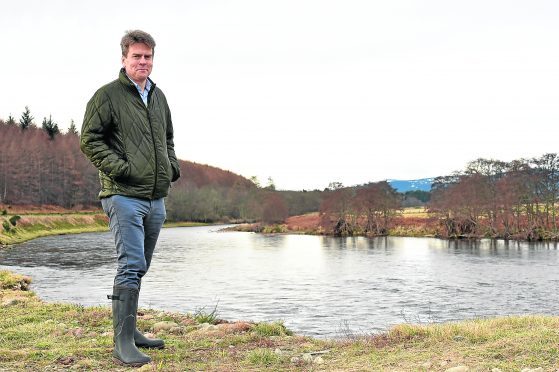It was a once-in-a-500-year event when Storm Frank engulfed Ballater and other parts of the north-east at the climax of 2015.
Yet two years later, those working in and around the affected areas, which saw hundreds of homes and businesses affected by devastating flooding, have sent out a message of regeneration.
Mark Bilsby, the director of the Dee Fishery Board at Mill of Dinnet, near Aboyne, was as shocked as anybody by the scale of the destruction.
But when he showed the Press and Journal around one of Scotland’s most cherished stretches of water, he also highlighted the remarkable amount of work which has been carried out to prepare for the future and ensure the success of the new fishing season, which commences on February 1.
And his response was clear: “There is a new River Dee today from what was there before the storm.”
Mr Bilsby, 46, a Mancunian who spent 10 years in the Outer Hebrides before moving to Deeside, has grown accustomed to dealing with the vagaries of the climate. But he acknowledges the road to recovery could not have happened without whole communities joining forces in a common cause.
He said: “It was a real force of nature. It engulfed villages, it smashed through the riverbanks, it pushed caravans into the water and damaged bridges – and if it had happened in the middle of the night, it doesn’t bear thinking about.
“But the reaction from the public to what happened was a reminder of the importance of the Dee and the work is still going on from so many volunteers in Aboyne, Ballater, Banchory, Dinnet… To Aberdeen and beyond.
“There are about 500 jobs involved with the salmon industry, and then you have all the associated other links to shops, pubs, hotels, the whole tourism business which thrives around the Dee.
“After the storm, there were a few anglers who got in touch and told us they wouldn’t be returning to the river that year. I think they reckoned it would take us a very long time to get back on our feet.
Pictures show the dramatic scenes one year ago after Storm Frank arrived
“But the vast majority of people have returned and the occupancy numbers for the 2018 season are very encouraging. And there are messages of support and groups seeking information about bookings arriving from all over the world.”
He said he had “no illusions” about the impact of the storm on many lives and conceded you “always have to be aware of how you can’t tame nature, you just have to learn to live with it”.
But he continued: “Here we are coming towards the end of 2017 and the river is cleaner than it was, the infrastructure is being refurbished, and salmon numbers are increasing.”
Mr Bilsby is aware of instances in Manchester and other parts of England, where their fish were lost due to apathy and neglect.
The Dee was not taken for granted in such a way however, he insisted, and while walking along the bank at Dinnet – and standing outside a spanking new hut for anglers – he pointed to various parts of the river and emphasised their transformation from how they looked prior Storm Frank’s trail of destruction.
In some places, banks were swept away, along with caravans, tonnes of silt and sediment, and such invasive plants such as giant hogweed. None of this was tackled
easily. As he explained, such an apparently straightforward job as getting mattresses out of the water proved an arduous task. So too, the salmon eggs which had been
planted deep in the sediment, were engulfed by the tempest and relocated.
Mr Bilsby added: “The volunteer network, which was set up, did an extraordinary job. And they are still on the job and improving all different aspects of the land and the river.
“The region knows that the Dee is a major asset and salmon are a very significant part of that. If their numbers are in good health, the chances are the same will be true of their environment.
“For me, salmon are like a canary in a coalmine. Storm Frank was a big wake-up call. But we now have organisations in place and groups who are doing their utmost to steer things forward and keep us all prepared.
“You can never say never, and these sort of major weather events seem to occur more regularly than in the past.
“But I think we are better prepared for them than we were in 2015.”
Twin Peakes are working to achieve success on the Dee
They’re the twin Peakes of the River Dee. And although their boss admits he finds it difficult to tell them apart, both Will and Al Peake share the same commitment to regenerating the north-east’s most famous waterway.
At 29, the English-born duo, who previously worked on the Isle of Lewis, have established themselves as popular ghillies, managing the river, hosting clients, educating tourists and liaising with officials from the River Dee Trust.
And they are both heartened by the fashion in which communities in the area have rallied together to orchestrate a recovery after the devastation of Storm Frank.
Will said: “The area’s on the road to the recovery and although there was a lot of destruction in 2015, people have really stood together.
“After it happened, we had a workforce arrive from Aboyne and they set about rebuilding tracks and riverbanks, helping restore the fishing huts, clearing a lot of silt and sediment, and generally clearing up the mess.
“Their efforts were invaluable and there is a definite feeling that things are moving forward.”
He added: “You never take anything for granted when you are working with nature.”










